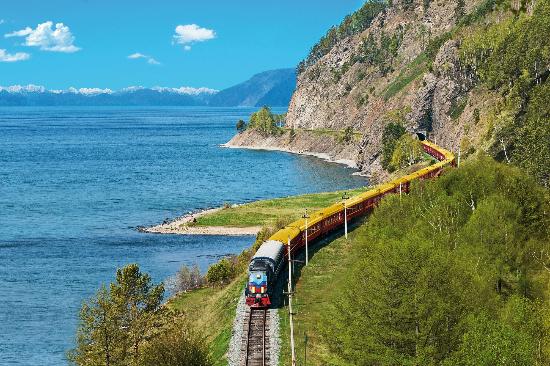 |
| Trans-Siberian Railway map |
Construction on the Trans-Siberian Railway began in May 1891. The main part of the system connected Moscow with the port of Vladivostok on the Pacific. Today that system runs between the two cities and a web of other cities for 9,297 kilometers (5,578 miles).
This monumental achievement was undertaken under very difficult conditions. The climate in Siberia and the dense forests, rivers, lakes, and mountains all presented obstacles to the builders. Materials often had to be transported for thousands of miles.
In addition, most of Russia where the rails were being laid was sparsely populated. The railway required thousands of Russian workers, many of them peasants, convicts, and soldiers. During 1895 and 1896 it is estimated that 85,000 individuals were at work on the railway.
  |
Initially, a section of the railway ran through Manchuria, avoiding the difficult construction that would have been faced if the system had been totally within Russian territory. However, after the Russo-Japanese War of 1904–05, officials decided that the route through China was too vulnerable to disruption. An alternate Russian route for this section was completed between 1908 and 1914. A connection between the Pacific coast and Chelyabinsk was opened in October 1916.
At the turn of the 20th century, as links of the railway were completed, the Russian people quickly accepted its usefulness. The number of passengers grew from 609,000 in 1897 to 3.2 million by 1912.
World War I slowed the growth of the railway and damaged many of the connections. Transport of troops and supplies clogged the single rail line, which could run only 13 trains a day. A special commission was appointed to make recommendations concerning the rail line.
 |
| Trans-Siberian Railway train |
The major recommendation of the commission was construction of a double line. By 1908 over 3,000 kilometers of the second line had been built, and the project was completed in 1918, but not before other events disrupted rail service.
The civil war within Russia did more damage to the railway system than foreign invaders might have. Up until the 1917 Russian Revolution, an international company had a contract with Czar Nicholas to manage the legendary Trans-Siberian Express between Moscow and Manchuria. The trip took nine days aboard a luxurious train equipped with sleeping cars, restaurant cars, a chapel, a music room, and a library.
Staff aboard the train included nurses and a hairdresser. The fighting during the revolution not only stopped this train but also destroyed many other railcars and locomotives. Bridges were blown up, and miles of track were ruined. Even with the heavy rebuilding that was needed, the railway was able to reopen in March 1925 and was not seriously interrupted after that.
During the 1920s Soviet dictator Joseph Stalin was able to use the existing railway system to intensify his industrialization of the Soviet Union. However, this plan was carried out by exploiting the resources of rural areas, leading to a near collapse of agriculture and to mass starvation in some of the republics.
During World War II, by transporting troops and supplies, the Trans-Siberian Railway and its connecting lines were again to prove essential in the Soviet resistance to German invasions.